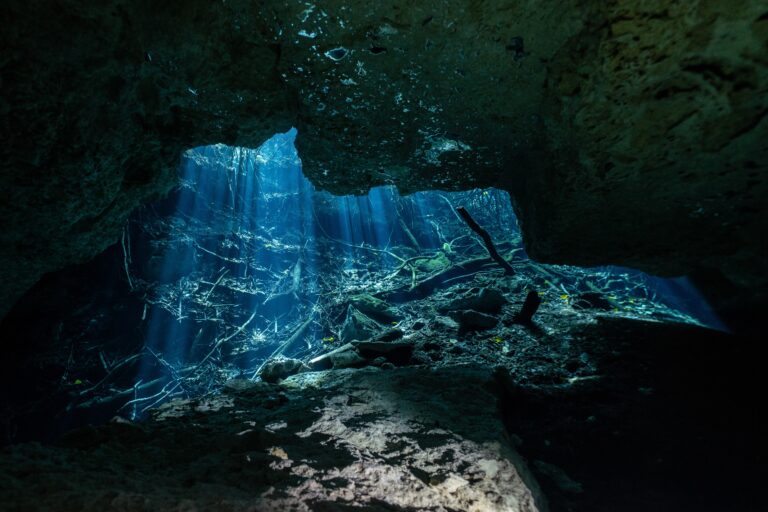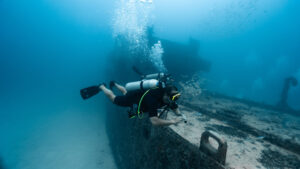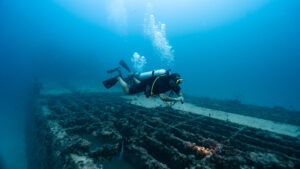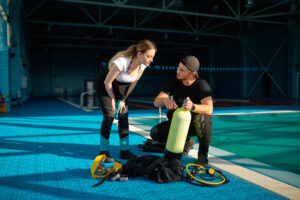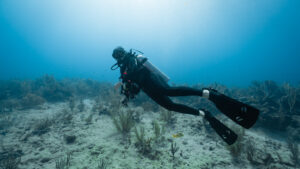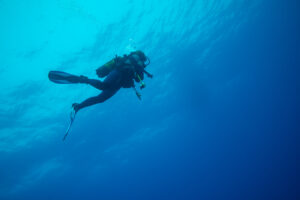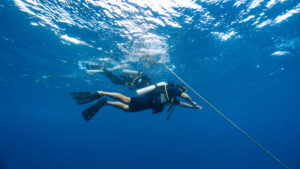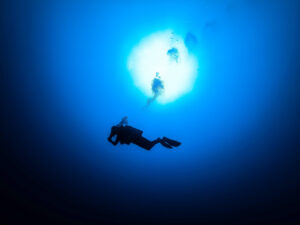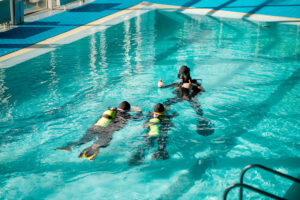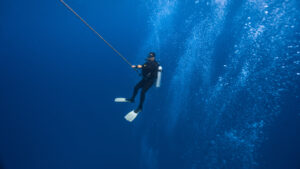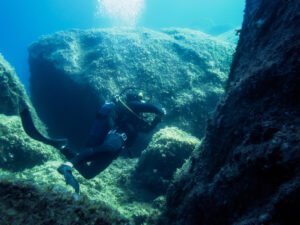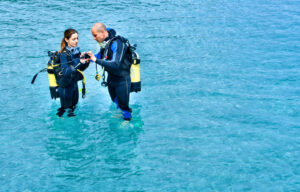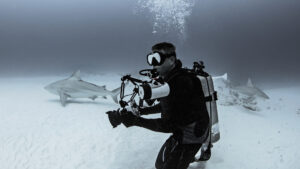What is a Cavern in the Context of Diving?
A cavern, in the context of diving, refers to a semi-enclosed underwater area where natural light is still visible and the entrance remains within view. These formations often occur in rock, creating unique and accessible underwater environments for divers. Cavern diving involves the exploration of these partially enclosed spaces, distinct from full cave diving, where the entrance may no longer be visible and natural light does not penetrate. Cavern divers can enjoy the sensation of venturing into more confined underwater environments while still maintaining the safety net of knowing they can see their way out and rely on natural lighting to guide their orientation. This article will explore the history of cavern diving, its unique geological features, required training and equipment, and the essential guidelines for ensuring safety and responsible diving practices.
History
The history of cavern diving is closely linked to the broader development of scuba diving. The first scuba systems, introduced in the 1940s, opened the door to underwater exploration for recreational purposes, and it wasn’t long before adventurous divers began exploring caverns and caves. In the early days, these dives were typically done without the advanced training or specialized equipment now required. Divers were often driven by a desire for discovery, as many of the world’s underwater caverns remained untouched and unmapped at the time.
Cavern diving, however, did not emerge as a distinct discipline until several decades later. By the 1970s, the scuba community had recognized the need for specialized training and safety protocols for divers who wanted to explore these unique environments. This recognition led to the development of the first formal cavern diving courses, with organizations such as the Professional Association of Diving Instructors (PADI) and the National Association of Underwater Instructors (NAUI) taking the lead. These courses introduced structured curricula focused on safe navigation, emergency procedures, and techniques designed specifically for cavern environments.
With the establishment of formal training, cavern diving grew in popularity throughout the 1980s and 1990s. Advances in scuba technology, such as the development of more reliable dive computers, better lighting systems, and redundant air supplies, made it safer for divers to venture into more complex and potentially hazardous environments. Today, cavern diving is a well-established niche within the scuba community, attracting both recreational divers looking for new challenges and seasoned divers eager to explore the geological and biological wonders found in these semi-enclosed spaces.
Geological Features
The geological formations that create caverns vary widely, but they are typically found in both freshwater and marine environments. Caverns are primarily formed by natural processes such as erosion, volcanic activity, or the dissolution of soluble rocks like limestone and gypsum. The geological forces responsible for shaping these caverns give them their distinctive features, and no two caverns are exactly alike. Some caverns consist of vast chambers large enough to hold entire ecosystems, while others form more intricate networks of interconnected passageways and tunnels.
Caverns are often distinguished by the striking presence of formations such as stalactites, stalagmites, flowstone, and columns. These formations result from the slow deposition of minerals over long periods of time. Stalactites hang from the ceiling, while stalagmites grow upwards from the floor, often forming after millions of years of mineral buildup from dripping water. Flowstone, a sheet-like formation, is created by flowing water that deposits layers of minerals, giving the cavern walls a smooth, sometimes glossy appearance.
The environmental conditions within caverns can vary significantly, depending on factors such as water flow, salinity, and the surrounding ecosystem. Freshwater caverns are often found in springs or along river systems, while marine caverns can be located along coastlines or on the ocean floor. In both environments, the caverns provide unique habitats for a wide range of aquatic life, from fish and invertebrates to specialized plant species that thrive in low-light conditions. The presence of light within caverns, which distinguishes them from fully enclosed caves, creates a unique interplay between the dark, enclosed space and the shimmering sunlight filtering through the water, illuminating the rock formations in spectacular ways.
Required Equipment and Training
Cavern diving, while offering a thrilling experience, requires specialized equipment and thorough training to ensure diver safety. Unlike open-water dives, where the surface is easily accessible, cavern environments present additional risks due to their enclosed nature. As a result, divers must be equipped with tools that allow them to navigate and manage their dive effectively in case of emergencies or unexpected complications.
Standard scuba gear forms the foundation of a cavern diver’s kit, but several additional items are essential. A primary light source, along with at least one backup, is critical for illuminating the often dim cavern environments. The lighting not only helps with navigation but also allows divers to appreciate the geological and biological features of the cavern. A guideline reel, along with line markers, is another indispensable tool. This reel enables divers to maintain a continuous path from the entrance to their furthest point of penetration, ensuring they can always find their way back to safety.
Cavern divers must also carry a redundant air supply. This typically takes the form of a pony bottle, a small backup tank, or double tanks. A redundant air system is essential to manage the risk of equipment failure, such as a regulator malfunction. Additionally, divers use dive computers or depth gauges and timers to monitor their depth and dive time carefully, avoiding any unplanned decompression or straying beyond safe dive limits.
Training for cavern diving is equally crucial and goes beyond the basics of open-water diving. Prospective cavern divers should enroll in a course from a reputable diving organization, such as PADI or NAUI. These courses combine classroom instruction with practical dive training, covering topics like gas management, emergency procedures, buoyancy control, and the unique hazards of cavern diving. During the course, divers also practice using guideline reels and performing emergency drills, such as sharing air with a buddy or handling equipment malfunctions in confined spaces.
Upon completing the course, divers receive a cavern diving certification. This certification is often required by dive operators to allow access to specific cavern sites, particularly those in more sensitive or challenging environments. The certification not only signifies that the diver has the necessary skills but also ensures they understand the importance of safety protocols and environmental conservation in cavern diving.
Guidelines for Safe and Responsible Cavern Diving
Safety is paramount when it comes to cavern diving, and divers must adhere to a strict set of guidelines to minimize risk and protect the delicate ecosystems found within caverns. The first rule of cavern diving is to always dive within your training and certification limits. Divers should never attempt to explore a cavern unless they have completed the appropriate training and are equipped with the necessary gear. Caverns can present a variety of hazards, including disorientation, poor visibility, and potential equipment failure, and only properly trained divers should navigate these environments.
Before entering a cavern, divers should carefully plan their dive. This includes familiarizing themselves with the cavern’s layout, identifying any potential hazards, and establishing a clear dive profile. A key part of planning is ensuring that a continuous guideline is maintained from the entrance to the furthest point of penetration. This guideline acts as a lifeline, ensuring that divers can always find their way back to the exit, even if visibility is reduced.
Another essential aspect of safety is air management. Cavern divers follow the rule of thirds, meaning one-third of their air supply is allocated for the journey inward, one-third for the return trip, and one-third as a reserve in case of emergencies. This conservative approach ensures that divers have enough air to handle unexpected delays or problems during the dive.
Proper buoyancy control is also critical in cavern diving, as poor buoyancy can lead to stirring up sediment, which can quickly reduce visibility and make it difficult to navigate. Divers should practice maintaining a horizontal position in the water and use efficient finning techniques to avoid kicking up silt or damaging fragile formations. Good buoyancy control also helps to prevent accidental contact with the cavern’s geological features, which can be easily damaged by careless movements.
Respect for the environment is another key principle of responsible cavern diving. Divers should avoid touching or disturbing any of the geological formations or the aquatic life found within the cavern. Caverns often host delicate ecosystems that can be easily harmed by human activity. By minimizing their impact, divers help to preserve these environments for future generations to enjoy.
Diving with a buddy is a standard practice in scuba diving, and it is especially important in cavern diving. Buddies should establish clear communication before the dive, using hand signals to convey important messages during the dive. Both divers should also review emergency procedures, such as what to do in the event of equipment failure or if one diver becomes disoriented.
Regular monitoring of dive computers or depth gauges is necessary to ensure that divers remain within their pre-planned dive profile. Cavern divers must avoid exceeding their no-decompression limits and be aware of their location within the cavern at all times. Should a problem arise, divers need to have contingency plans in place, whether it’s dealing with an entanglement in the guideline or a sudden equipment malfunction.
For those who are new to cavern diving, hiring a qualified guide can be a good option. Experienced guides not only help enhance safety but also provide valuable insights into the cavern’s features and history. They can assist in navigating more complex or unfamiliar environments, ensuring that divers have an enjoyable experience without compromising their safety.
Key Takeaways
Cavern diving offers scuba enthusiasts a unique opportunity to explore semi-enclosed underwater spaces while still maintaining a connection to the surface. By following the required training, using specialized equipment, and adhering to strict safety guidelines, divers can safely experience the thrill of cavern diving and appreciate the geological and ecological wonders of these fascinating environments.

